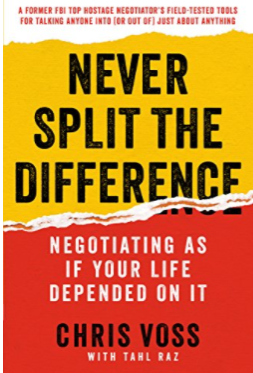
Today we’re going to talk about using empathy to get what you want when negotiating. The tips in Chris Voss’ excellent book on negotiating, Never Split the Difference, will help you in all areas of life, which is why I’m featuring it on Writing Tip Wednesday.
Last time we talked about how you should not be unsettled when the other party says “No.” “No” usually means that the other person is protecting his autonomy and that he isn’t ready to agree yet or to do what you want him to do yet. When someone says “No,” he’s not saying that he refuses under any circumstances. Rather, he likely needs more information or needs to think about it.
Adding to this arsenal of negotiation tactics is the use of, as Voss puts it, tactical empathy. Voss’ overarching theme is to work with the other person’s energy to get to a place you’re comfortable with, rather than browbeating the other person into submission. This strategy works with peers, coworkers, and even with your kids.
Turn your logic switch off and your empathy switch on
To successfully use Voss’ techniques, suspend your use of pure logic. This was a mental block for me for a long time. I’m a consummate rational actor, and did not understand how using empathy would get the other person to agree with me on something. I didn’t find it logical that someone would agree with me simply because I showed that I cared about the same thing they did. But it works.
In martial arts such as aikido, you use your opponent’s body positioning and center of balance to make them move where you want in order to defend yourself. You work with the other’s energy instead of fighting it. When negotiating, you LISTEN so that you can understand where the other person is coming from. Next, you show them that you HEAR them, and that you UNDERSTAND THEIR POSITION. When you connect with the other person in this way, they are way more willing to do what you want them to do. It’s human nature. Not only that, the entire process will be relationship-affirming rather than adversarial. Here’s how you do it.
Tactical Empathy in a Nutshell
Here’s how to show empathy and connect with the other person:
Imagine yourself in the other person’s situation, as if you were them. Try to feel what they are feeling. Note that you do not have to agree with them, or think the same way they do. You only have to consider things from their point of view.
Use mirroring to reflect back to them what they are saying to show that you hear and understand them. After you mirror, wait. Let the silence do its work. This technique is based on human neurobehavior, where humans copy each other in order to comfort each other and create rapport.
It’s almost laughably simple: … a “mirror” is when you repeat the last three words (or the critical one to three words) of what someone has just said.
Chris Voss
Use labeling to show them that you understand them. Recognize and verbalize the other person’s emotional state, thereby validating the person’s emotions. Identify the person’s feelings, and calmly and respectfully repeat their emotions back to them.
Here’s a great example of labeling in action. Voss recounts an episode where, as a hostage negotiator, he responded to a scene where three fugitives were holed up on the twenty-seventh floor of an apartment building. For about six hours, he and other negotiators took turns speaking to the fugitives through a closed door. For the entire six hours, the negotiators said, “It looks like you don’t want to come out. It seems like you worry that if you open the door, we’ll come in with guns blazing. It looks like you don’t want to go back to jail.”
In this example, the fugitives eventually surrendered. When asked about it, they told the negotiators that it seemed as if law enforcement wasn’t going away so they may as well come out. Amazing.
Note that, according to Voss, labeling almost always begins with these words:
- It seems like…
- It looks like…
- It sounds like…
Don’t overreact when they tell you “No.” In fact, don’t overreact at all. Go slowly. As Voss states, calm the schizophrenic. That is, calm the angst of the person. If you’re wound up and antsy, the other person will be, too. For you parents, have you noticed that when you get wound up and irritated, your kid gets wound up and irritated, too? And have you also noticed how, if you always remain calm under pressure, the chance that your kid will be calm, too, increases exponentially?
Ask calibrated, probing questions. Ask the other person open-ended questions to invite them to explain what would help them get to an agreement. This is a major part of Voss’ book. Negotiating, in his mind, is a process of discovery, not an adversarial process. You will accomplish much more by using Voss’ tactics than you will by steamrolling the other person. And if you use these tactics when parenting, like I do, they will help you affirm and strengthen your relationship with your children rather than reinforce an us versus them mentality.
Voss states to use calibrated questions early and often in a negotiation. Here are some great examples:
- What is the biggest challenge you face?
- What would need to happen for you to feel comfortable with this?
- What about this is important to you?
- How would you like me to proceed?
- How can we solve this problem?
Note that all of these questions invite the other person to elaborate, giving you more information about their position and situation. These open-ended questions also put the other person in the driver’s seat, giving them a feeling of control. By doing so, they will be more likely to get to where you want to be.
The next time you have an important negotiation or discussion coming up, use Voss’ tactics. You will not be disappointed.
Get helpful writing tips and more
in your inbox
Join the tribe and get free fiction and self-publishing tips.
Thank you for subscribing.
Something went wrong.

Be First to Comment